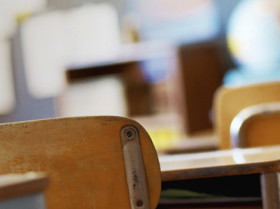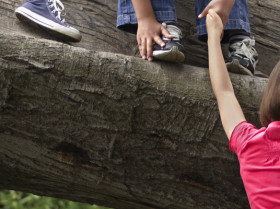This past week I was invited to a local school district here in St. Louis to share the Sport Education (SE) instructional model to middle and high school physical education teachers. A long-time and well-respected (for good reason) physical education professional, Dr. Daryl Siedentop, developed the SE model in the early ’90s.

Why?
Dr. Siedentop suspected that if students were more engaged in modified sport experiences that resembled real-life sport culture, they would be more excited about participating in sport outside of physical education (PE) class. Rather than do a sport for a few days with no real-life sport experience in terms of fans, tournaments, championships, etc., Siedentop felt SE would make the learning environment more fun. He also recognized that traditional sport in PE might not have allowed students to develop physical competence that would want, so he suggested small-sided sport experiences. The SE model includes the additional key elements:
- Sport done by season
- Students on the same team throughout “season”
- Formal competition interspersed with practice
- Culminating events/season
- Excessive record keeping
Festival atmosphere during culminating event
Before we get into more detail about the SE model, it must be clear that games and modified sport (in my humble opinion) should only be one of several key strands of movement categories in which we teach physical education curriculum outcomes. In Amandaville, a balance of the following categories would include:
- Modified sport/games (hence, where SE model might fit)
- Educational gymnastics/modified wrestling games (body awareness, strength, balance, agility, etc.)
- Dance
- Individual pursuits (includes activities such as kayaking, yoga, mountain biking, triathlon, hiking, etc.)
Additionally, each of the above four groups of movement categories should teach the whole child.
- Physical Domain (fundamental movement skills, strategies, tactics - will be independent in early years and then combined and more advanced as students grow)
- Cognitive (Intellectual) Domain (know, understand, apply, evaluate information as it is age and developmentally appropriate - more concrete during early years)
- Affective (Emotional) Domain (valuing living a healthy life)
- Moral (fair play, personal and social responsibility)
Now that we are all on the same page, let’s dig deeper into Seidentop’s SE model…
When I think about the SE model I am not without concern. For example, SE model suggests that the teacher teaches one particular sport for an entire season (in this case, Siedentop recommends at least 12 lessons). While this should include small-sided modified games, I typically adhere to the Teaching Games for Understanding instructional model of teaching skills (physical competence), strategies, and tactics (games sense). In this model (TGFU), modified games (not adult versions of sport) are taught within categories of games and one sport is never the focus. TGFU proceeded SE and was developed by Bunker and Thorpe. Rather, skills and strategies learned in modified versions of several sports allow students to increase competence and games sense. These categories include:
- Target games - object lands close to pre-determined target (e.g, golf)
- Striking and Fielding games- players send object to space (e.g., baseball, cricket)
- Net and Wall games - players send object over net or to space at wall (tennis)
- Invasion games - players move object to opposition’s zone and successfully attacks ‘goal’ area (e.g., speed ball, ice/field hockey)
Back to the SE Model. In this model students are supposed to have the following roles:
- Coach
- Team captain
- Stats keeper
- Manager
- Official(s)
- Player(s)
- Score keeper
Do you see any red flags here?
I did. I wondered, “Why would I ever want a student serving as a score keeper for a 12 day unit?” “What about physical activity at moderate to vigorous physical activity?”
I didn’t really want to lead a session on SE model without TGFU. I wanted to somehow combine the best of both models. I also wanted to examine two elements of physical education that have been thrown into the mix since both models’ inception.
Enter: 21st Century Learning Skills (critical thinking, collaboration, risk taking, creativity) and Technology
Both models (SE and TGFU) represent constructivist learning theory. I love this! In other words, both models support the active learner (students aren’t passive, involved in critical thinking), the social learner (students construct knowledge through social interactions with peers and teachers), and the creative learner (students are guided to construct knowledge, often from past experiences). Seidentop’s primary aim was to have the more novice (in terms of physical competence) learners more engaged in their learning. He felt that if they all had a role on the team, and the teams stayed together for a duration, they would feel a part of something and less marginalized in PE. Research suggests the SE model was successful at doing just this (Dyson, Griffith & Hastie, 2004).
While all of this is great, but it still doesn’t solve my dilemmas. And then, a light bulb went off (it probably went off with you years ago, so forgive me if this post is actually yesterday’s news!)
When I began to think about how this model fit in a 21st century learning space, I got excited. We need to foster 21st century skills in our students. We have no idea what our classrooms will look like in 20 years, so we darn well better prepare our students for the unexpected.
I wondered, “What if the students had to determine {critical thinking, creativity} ways (together {collaboration}) that the score keepers, coaches, statisticians, officials, etc. could do their roles competently while also attaining adequate moderate to vigorous intensity physical activity, and strength/balance/flexibility practice each class?” They could share this information with their peers {risk taking} and use creativity {technology} to do so prior to class time.
Re-enter technology. You all know my thoughts on this. I love technology. I just think that we sometimes use it for the wrong reasons in physical education (you can read more about that here). I’m suggesting that technology by students to determine and then disseminate what they have come up with to provide health-giving activities for traditionally sedentary roles within the SE model and sport in society.
SE and TGFU for the 21st Century Learner (While Utilizing Technology)
I dare you say the above heading fast 5 times.
NOW, for best practice, we take what is great about the SE model (student-centered, fun environment, everyone has important role on the team, teams get to really develop a bond through the ’season’),
and add in…
what is great about the TGFU model (small-sided, student centered, critical thinking, competence in a wide variety of different types of games),
with a dash…
of 21st century learning skills,
and a sprinkle of…
positive technology integration!
Some schools are 1:1, others are BYOD, and yet others encourage class Twitter accounts, etc. There are no limits in how students might determine ways to share their creative strategies to get folks moving who might otherwise have sedentary roles (e.g., scorekeeper).
If I were teaching the class, I would ask students to choose activities to help them reach their personal fitness goals related to their self-appraisals. The idea around this is? That our students grow up to view physical activity, goal-setting, and a plan to attain a healthy zone as normal. What would this look like? The sky’s the limit! Maybe stationary bikes come to the sidelines and score keepers ride while they keep score. The long-term impact of such creative strategies could be future community sporting facilities build spaces that support population-level physical activity as the norm. We need a culture-shift and by holding on to these two models, and then giving them a twist, we can help raise truly physically literate students who are aware of community planning and creative thinking around how to live a healthy lifestyle.
Times, they are a changin’.
We should all constantly reflect current models and our current practice. While books were written on each of these models, I just wanted to re-introduce them to you in a combined way to get us all thinking about something that has been around for a while, and how we might revise it slightly to best suit current needs in our schools. I look up to Don Hellison’s work so much. He calls his Teaching Personal and Social Responsibility (TPSR) a model in practice because it’s constantly evolving. I think that we should all follow his example of re-examining the instructional models we use in our physical education classes to best meet the needs of the learners in our 21st century classrooms. This was one attempt to do that and I hope your students enjoy the challenge of working together to come up with ways that all people in society can find ways to be active, as non-traditional as these might seem to those of us around the past few decades!
What do you think?
Do you use SE and/or TGFU models in your classes currently?
How have you increased MVPA in the SE model in the past?
How might you incorporate technology into this type of combined model to support 21st century learning skills and increase physical activity at MVPA intensities?






